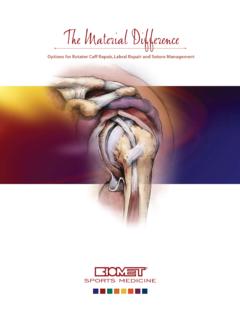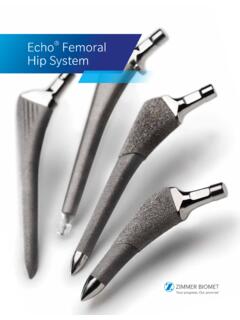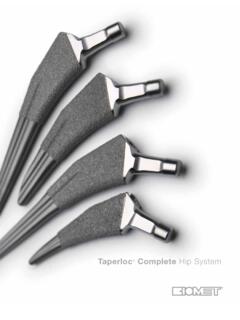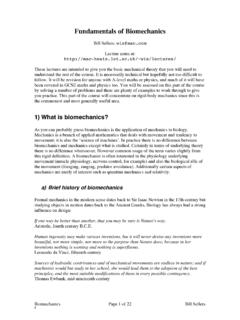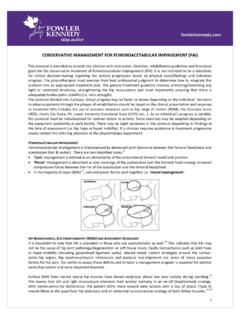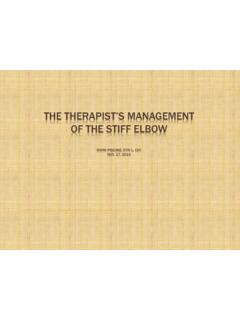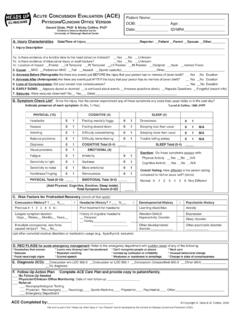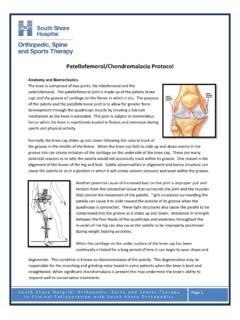Transcription of G7 Acetabular System - Zimmer Biomet
1 G7 AcetabularSystemSurgical TechniqueTable of ContentsQuick Reference Guides ..2 Device Description ..6 Preoperative Templating ..7 Patient Positioning ..8 Acetabular Exposure ..8 Acetabular Reaming ..9 Optional Shell Trialing and Alignment ..10 Positioning GuidesLiner Trialing with Provisional Reduction and Range of Motion ..16 Acetabular Shell Insertion ..17 Supplemental Screw Fixation ..21 Optional Liner Trialing with Final Implant ..23 Optional Apical Plug ..24 Polyethylene Liner Insertion ..24 Ceramic Liner Insertion ..26 Modular Head Selection and Impaction ..29 Final Reduction ..29 Polyethylene Liner Removal ..30 Ceramic Liner Removal ..33 Primary Shell Removal ..33 Straight and Curved Inserter Handle Disassembly ..34 Indications ..69 Contraindications ..692 | G7 Acetabular System Surgical TechniqueStep 7:Liner TrialingStep 3:Instrument SelectionStep 8:Liner InsertionStep 9:Final ReductionStep 4:Shell Trialing (optional)Step 5:Shell InsertionStep 6:Supplemental Screw Insertion (optional)Step 2:Reaming Note: There may be slight variations in colors between p 1.
2 Preoperative Reference Surgical TechniqueBIOLOX delta3 | G7 Acetabular System Surgical TechniqueG7 Family Tree Acetabular ShellsOsseoTi Limited and Multi HolePPS and BoneMaster ** Limited HoleFinned PPS and BoneMaster** Limited HoleNeutral +5 Neutral* High Wall10 Degree Face ChangingE1 and ArComXL PolyethyleneDual Mobility(CoCr only)Dual Mobility Bearing(E1 & ArComXL)Dual Mobility*BIOLOX deltaCeramic**+5 Neutral*10 Degree Face Changing*E1 Freedom Constrained PolyethyleneNeutralCoCr ModularFreedom CoCrBIOLOX deltaBIOLOX delta OptionLinersFemoral Heads* Check for country product clearances and reference product specific instructions for use.** Not for sale in the | G7 Acetabular System Surgical Technique45 Apex Minimum Poly Liner Thickness at 45 (mm) Minimum Poly Liner Thickness at Apex (mm)Shell SizeHead .. *11 . 374767880J*14. 312 . SizeHead .. *11.
3 774767880J* . * Available in OsseoTi Multi hole configuration onlyQuick Reference Polyethylene Guides5 | G7 Acetabular System Surgical TechniqueQuick Reference Polyethylene GuidesPolyethylene Articulation Sizing10 Degree Face Changing Leg Length ChartShell SizeHead Size28323640444244AA - 2846BB - 28B - 3248CC - 28C - 3250DD - 28D - 32D - 3652EE - 28E - 32E - 365456FF - 28F - 32F - 36F - 405860 GG - 28G - 32G - 36G - 406264HH - 32H - 36H - 40H - 4466687072I*I - 36I - 40I - 4474767880J*J - 36J - 40J - 44 Cup SizeLine SizeOffset (mm)Leg Length (mm)Lateralization (mm)42 mm44 .146 mmE4 .13 . mm56 mm60 mm64 .166 mm68 mm70 mm72 mmI5 . mm76 mm78 mm80 mmJ* *Available in OsseoTi Multi hole configuration only6 | G7 Acetabular System Surgical TechniqueDevice DescriptionThe hemispherical design of the G7 Acetabular shell provides fixation and stability with proven1 7 PPS Porous Plasma Spray Coating or OsseoTi Porous Structure.
4 Multiple bearing options are also available, including E1 Antioxidant Infused Technology, ArComXL Polyethylene and BIOLOX delta ceramic G7 Acetabular System utilizes a unique color coding System designed to offer an efficient operating experience. The provisional shells, provisional liners, labels and face plate impactors match the color anodized on the rim and letter designation of the Acetabular shell implant (F i g u r e 1).The G7 Acetabular System color and letter coding key is listed in Figure 2. Note: Implant identification should be made using letter and size information. Color coding should be used only as a secondary reference. There may be slight variations in colors between 1 Figure 2G7 Acetabular System Color & Letter Coding KeyColor and Liner SizeShell Size(s)A42,44 mmB46 mmC48 mmD50 mmE52 mmF54,56 mmG58,60 mmH62,64 mmI66, 68, 70*, 72* mmJ*74, 76, 78, 80 mm*Available in OsseoTi Multi hole configuration onlySurgical Technique7 | G7 Acetabular System Surgical TechniquePreoperative TemplatingAccurate preoperative planning and Acetabular templating help determine the size, desired location and position of the Acetabular shell and are an essential part of the surgical process.
5 Templating is best performed with an A/P pelvis radiograph with the limb internally rotated approximately 15 degrees. This allows more accurate determination of femoral offset, radiographic leg length inequality, and referencing of contralateral hip, if examining the A/P radiograph, the shell should be positioned against, but not medial to, the radiographic teardrop at 40 degrees of inclination. Acetabular shell size is best determined on a cross-table lateral radiograph. If the patient s anatomy is obscured, it may be helpful to check the Acetabular component size on the contralateral hip radiograph, as well. Make note of the shell size that fills the Acetabular space appropriately and fits the anterior to posterior diameter of the native acetabulum, keeping in mind that final decision on shell size should be made during surgery when adequate visualization of the acetabulum is achieved.
6 Note: Use of an X-ray magnification marker is needed to template with OrthoSize Digital Templating Software. The magnification marker can be located against the joint (ball/coin) or on the table (coin/ruler), but must be visible within the X- r | G7 Acetabular System Surgical TechniqueFigure 3 Patient PositioningThe G7 Acetabular System is designed to be used with all surgical approaches (Figure 3). Acetabular ExposurePrior to reaming, Acetabular exposure should be adequate and the anterior, posterior and superior walls should be directly visible. The medial Acetabular wall, which dictates the depth of the reaming, should be uncovered of floor osteophytes or pulvinar pad. Specialized Acetabular retractors are available to help facilitate exposure for whichever approach is | G7 Acetabular System Surgical TechniqueAcetabular ReamingDetermine a starting reamer size from the preoperative template and from the measured diameter of the resected femoral head.
7 This is typically 6 8 mm smaller than the femoral head diameter. Reamer handles are provided as straight or curved (offset). Use is dictated by surgeon preference, surgical exposure, and patient body composition. During the reaming process, frequently determine the amount of anterior and posterior Acetabular bone remaining to avoid reaming away the wall and compromising with a small reamer, apply constant pressure first toward the medial wall, appropriately medializing the acetabulum for optimal hip biomechanics and the normal center of hip rotation. Gradually progress to larger reamers, while maintaining concentricity within the Acetabular cavity until bleeding subchondral bone is exposed (Figure 4).The preferred Acetabular orientation is 40 degrees inclination and 20 degrees of anteversion, but final Acetabular position depends on patient anatomy and may vary slightly with approach.
8 Final orientation of the Acetabular implant is also dictated by the amount of version of the femoral implant ( , greater anteversion of the Acetabular component may be required in the case of a retroverted stem). Under-reaming of the acetabulum is dependent on bone quality and should be determined by the surgeon intraoperatively as soft bone will more readily accommodate a larger press-fit than harder, sclerotic bone. The following reaming recommendation may be used as an initial guideline:Figure 4 Acetabular ShellRecommended Under Ream*G7 PPS and OsseoTi Hemispherical Shell 1 mm under final implant sizeG7 Finned** Hemispherical ShellLine to line* This is a general recommendation only, appropriate reaming is dependent on bone quality and should be determined by the surgeon intraoperatively.** Check for country product clearances and reference product specific instructions for | G7 Acetabular System Surgical TechniqueAcetabular Reaming (cont.)
9 Once reaming is complete, use the provisional shells to confirm the position and accuracy of the reaming. Final shaping must be achieved using the hemispherical grater reamer to ensure a congruent fit between the shell and the acetabulum. Note: All G7 Acetabular shells are measured over porous coating or structure. All Acetabular shells, provisional shells and Acetabular reamers are marked true to size. All components are a full hemisphere and measure 180 degrees (Figure 5).Figure 5 Optional Shell Trialing and Alignment Once the desired ream has been achieved, select a provisional shell that is 1 mm smaller than the final implant. The provisional shell is marked with its true size and indicates the corresponding liner size both alphabetically and by color (Figure 6). The shell gauge handle may be threaded to the Acetabular shell provisional and used to gauge the size of the reamed acetabulum (Figure 6).
10 Note: Do not impact on the shell gauge 647 mm180 47 mm180 48 mm180 11 | G7 Acetabular System Surgical TechniqueOptional Shell Trialing and Alignment (cont.)Alternatively, utilize either the straight monoblock, curved or straight modular inserter handle. Place the provisional shell into the acetabulum at approximately 40 degrees of inclination and 20 degrees of anteversion. When using the curved or straight modular handle, place the appropriate threaded shaft into the handle through the hole in the strike plate of the straight modular handle (Figures 7 and 8), or the hole at the distal tip of the curved inserter handle (Figure 9). If using the G7 Straight Monoblock Inserter Handle, assemble to the mating component by rotating clockwise and disassemble by rotating counter-clockwise. Ensure the G7 Monoblock Inserter Handle is fully threaded to the mating component prior to impaction.
